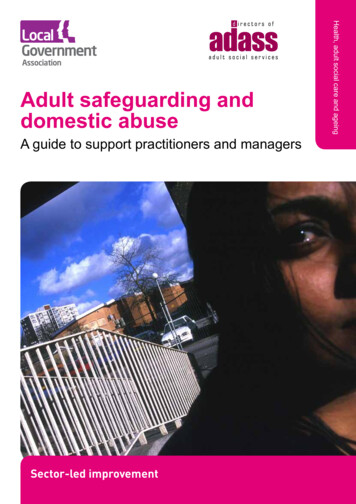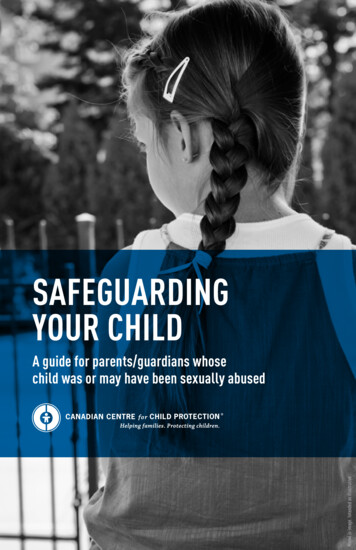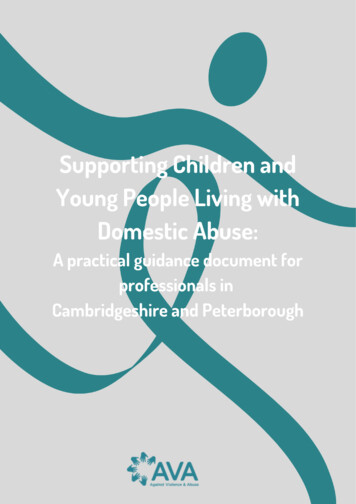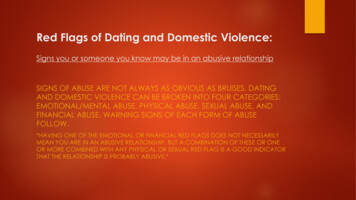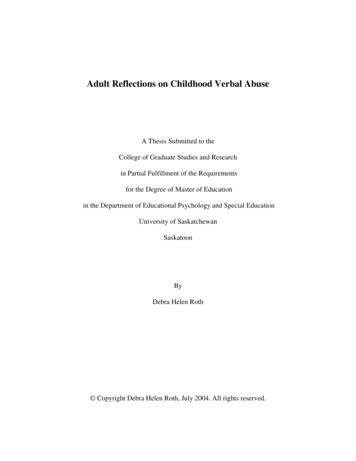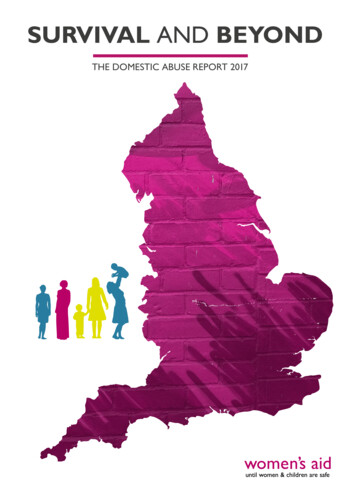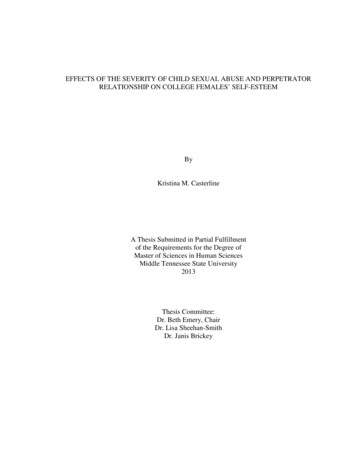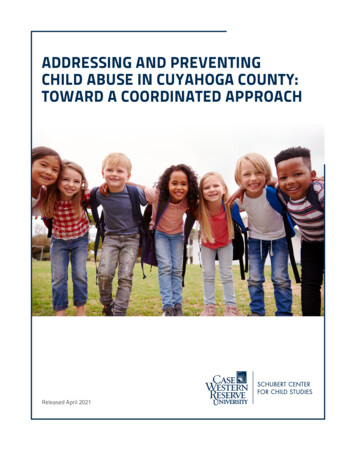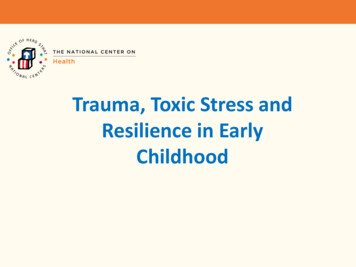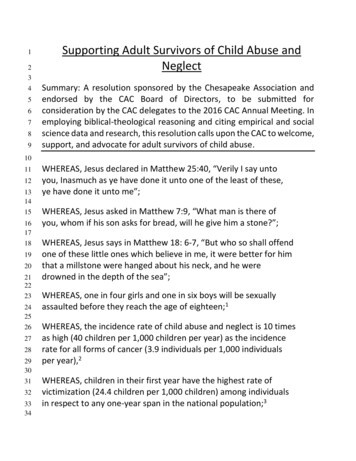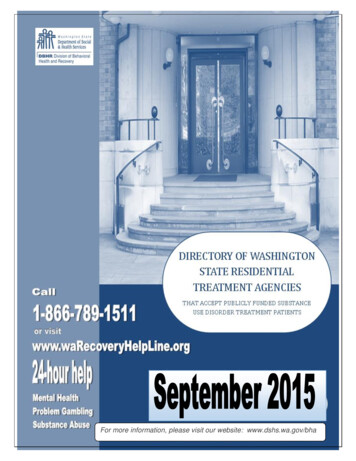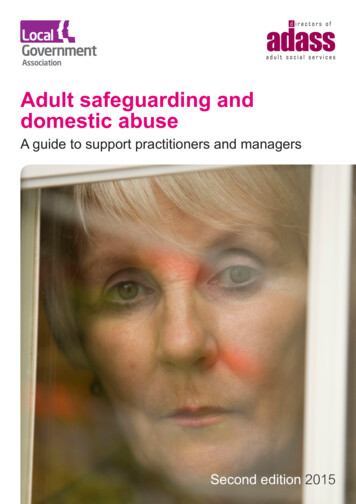
Transcription
Adult safeguarding anddomestic abuseA guide to support practitioners and managersSecond edition 2015
ContentsIntroduction: quick reference guide61.Making the connections between adult safeguarding and domestic abuse9Who this guide is for9What this guide sets out to achieve92.What is domestic abuse? Who needs safeguarding? And how do they link together?11Definition of domestic abuse11Definition of safeguarding11Family and intergenerational abuse12Making the links between adult safeguarding and domestic abuse12Making the links with children’s safeguarding132.1 What research tells us3.13Gender and domestic abuse13Domestic abuse in LGBT relationships14Age, disability, mental health and domestic abuse14Case example one15Understanding the impact of domestic abuse17What is the impact of domestic abuse?17What might be the additional impacts on people with care and support needs?17Voices from research and practice: one18
4.5.Barriers and challenges to ending abusive relationships19What are the barriers to seeking help?19What are the additional barriers to seeking help for people from a BME background?20What are the additional barriers for adults with care and support needs?20Independence and self-esteem21Parenting21Voices from research and practice: two21Working with people needing care and supportwho are experiencing domestic abuse23Legal obligations23Principles for work23Voices from research and practice: three25Practice: giving opportunities to develop trust, disclose abuse, and seek help255.1 Specific types of abuseForced marriage26Case example two27Other domestic abuse within families275.2 Working with specific groups6.2628Older people28People with mental ill-health29People who misuse substances29People with learning disabilities30Carers who are at risk of harm and/ or harm30Case example three31Mental capacity, adult safeguarding and domestic abuse34Mental capacity to take decisions34An unwise decision or a decision taken under duress?34Case example four36People who lack capacity and Independent Mental Capacity Advocates (IMCAs)36
7.8.9.Safe enquiries38Enquiring safely about violence or abuse38Best practice in undertaking safe enquiry38Assessing and managing the risks of domestic abuse in safeguarding circumstances40Involving the person at risk40Using risk assessment tools and exercising professional judgement40Multi-agency Risk Assessment Conferences (MARACs)or a multi-agency safeguarding meeting?41MARACs and safeguarding procedures41Case example five42Common barriers to effective risk assessment and management42Domestic abuse support services and legal action45Domestic abuse support services45Accommodation and support packages46Case example six46Voices from research and practice: four47Criminal law48Domestic Violence Protection Notices and Orders48Civil law49Case example seven50Obtaining good legal advice5110. Working with perpetrators of domestic abusePerpetrators of domestic abuse10.1 Perpetrators with care and support needs525253People with mental ill health53People who use substances53Case example eight5411. What councils and organisations can do to support good practice5512. References and useful resources57
AcknowledgementsThe guide was written by Sue Lewis and CathieWilliams and first published by the LocalGovernment Association in April 2013.This second edition which includes updateswas commissioned from Research in Practicefor Adults and written in October 2014 by RuthIngram and Lindsey Pike, with thanks to NickiNorman from Women’s Aid, Jo Silver fromCAADA, and Maria Gray and Lee Barnard fromthe Metropolitan Police.Key parts of it draw significantly on the multiagency protocol produced by ManchesterSafeguarding Adults Board and ManchesterSafeguarding Children Board for local use –“Working Together To Safeguard Adults andChildren from Domestic Abuse”.Thanks are also due to Wirral Adult SocialServices Department and partners for theirwork in testing out and advising on the contentof the guide during its development.Finally, the many helpful comments andsuggestions sent by councils and otherpartners during the consultation phase havebeen very useful and are much appreciated.The work of Co-ordinated Action AgainstDomestic Abuse (CAADA) and Women’s Aidhave been drawn on extensively to inform bestpractice in relation to domestic abuse.The references and resources, alongwith other useful information, can be foundon the Safeguarding Adults Community ofPractice Group on the LGA Knowledge uardingcommunityofpracticeAdult safeguarding and domestic abuse – a guide to support practitioners and managers5
IntroductionQuick reference summary guideA considerable proportion of safeguardingadults work relates to the abuse or neglectof people with care and support needs whoare living in their own homes. Domestic abuseis perhaps most commonly thought of asviolence between intimate partners, but it cantake many other forms and be perpetratedby a range of people. Much safeguarding istherefore also domestic abuse. This guide setsout the overlaps between safeguarding anddomestic abuse and the approaches and legalframeworks for domestic abuse that can beused in the safeguarding context.This section provides an overview of the keymessages contained through the document,which has been designed to refer to asneeded.1. Making the connections between adultsafeguarding and domestic abuse follow your local policies, protocols andprocedures for safeguarding adults andchildren, and for domestic abuse use this guide to improve understanding ofthe issues and develop good practice.2. What is domestic abuse? Who needssafeguarding? How do they link together?And what does research tell us? understand the definitions of safeguardingand domestic abuse, and how they link up forthe person you are supporting be alert to patterns of coercive or controllingbehaviour, as well as incidents of abuse always act to safeguard children who areliving with or witnessing domestic abuse take account of gender, sexuality and intergenerational issues.63. Understanding the impact of domesticabuse consider the likely impact of abuse on alladults and children involved consider the additional likely impacts ofabuse on people with additional care andsupport needs consider how these factors might affect theapproach in working with the person at risk(and others in the household).4. Barriers and challenges to ending abusiverelationships there are many reasons why people may notleave abusive relationships additional and specific barriers may bepresent for ethnic minority people, olderpeople, and people with disabilities confidentially asking routine questions aboutsafety can aid disclosure accessible information and signpostedservices about abuse are crucial building trust with someone to help themdisclose abuse may take some time.5. Working with people needing careand support who are experiencingdomestic abuse there are a range of issues to consider,including the needs of a range of groups,people’s independence, self-esteem,previous experience of services, andparenting taking time to build trust and confidencewith the person being abused is important,accepting that they may not be able todescribe or disclose all aspects of theirsituation initially, and that the issues maytake time to explore fullyAdult safeguarding and domestic abuse – a guide to support practitioners and managers
avoid making assumptions based onstereotypes, particularly around older age,mental health and substance misuse there is a risk of serious harm in forcedmarriage situations where one or bothparties have care and support needs domestic abuse can involve the widerfamily and take different forms according todifferent family dynamics, especially whencaring responsibilities are involved.6. Mental capacity, adult safeguardingand domestic abuse the Mental Capacity Act has five keyprinciples, designed to protect and supportthe person an apparently unwise decision may be theresult of coercion or controlling behaviour byanother person Independent Mental Capacity Advocates(IMCAs) can support the abused person IMCAs may not be specially trainedin domestic abuse, but they can workalongside Independent Domestic ViolenceAdvocates (IDVAs) or other workers from aspecialist domestic abuse agency.7. Safe enquiries follow the principles of safe enquiry andtake protective measures to ensure that anydiscussions with potential victims of abuseare conducted in a safe environment understand that victims of abuse may bereluctant to disclose what is happeningto them, but that the conversation may behelping them to understand their situationbetter and build up trust ask direct questions, in a safe environment keep good records of any discussions andinterventions follow local policies, protocols andprocedures at all times.8. Assessing and managing the risksof domestic abuse in safeguardingcircumstances understand how coercive and controllingbehaviours may inhibit people disclosing orrevealing the extent of domestic abuse understand local policies and procedures forsafeguarding and risk assessments listen to and communicate respect towardsthe adult with care and support needs whois experiencing domestic abuse. Ensure theyare at the centre of decision-making be aware of and vigilant against the potentialof ‘the rule of optimism’, when professionalsmay place undue confidence in the capacityof families to care effectively and safely,affecting professional perceptions andrecognition of risk of harm, abuse or neglect take any immediate protective measures thatare needed understand how your local arrangementswork in relation to safeguarding and MultiAgency Risk Assessment Conferences use risk assessment forms as tools to aidprofessional judgement, not as ends inthemselves using safe enquiry, work with the person atrisk to ensure their experiences are centralto your risk assessment collate information about static risk factors,as they are the most reliable indication oflong-term risk use professional judgement in riskassessment as everybody’s circumstancesare different gain support from local specialist domesticabuse agencies; they are experts in riskassessment and management.9. Domestic abuse support servicesand legal action ensure that you develop safeguarding andsupport arrangements that are personalisedto the person you are working with there are many types of national and localsupport schemes for people experiencingdomestic abuse, including places ofimmediate safety be aware of the types of legal actions andsanctions (criminal and civil) that can beused in safeguarding and domestic abuse.Adult safeguarding and domestic abuse – a guide to support practitioners and managers7
know where to go to get good legal advice,both for the person you are supporting, andto advise you of the options available ensure that information and advice isprovided in an accessible way.10. Working with perpetrators ofdomestic abuse carry out safe enquiry and risk assessmentfor every person at risk of abuse, whateverthe circumstances of each individual be aware of the need for specialistintervention programmes for perpetrators,which challenge their behaviour and offerappropriate support do not refer perpetrators to interventionssuch as anger management, genericcounselling or mediation between theperpetrator and victim if it is within your role to have directcontact with a perpetrator and to speakabout domestic abuse, be clear with themabout the unacceptability of abuse, theiraccountability for it, and the limits onconfidentiality if someone is abusive or neglectful and theythemselves have care and support needs,make sure they have access to informationand advice, assessment and support ensure professionals working with theperpetrator and those working with the victimare part of a ‘virtual team’ and are activelysharing information relevant to delivering thesafeguarding plan be aware of and vigilant against the potentialof ‘the rule of optimism’, when professionalsmay place undue confidence in the capacityof families to care effectively and safely,affecting professional perceptions andrecognition of risk of harm, abuse or neglect.11. What councils and organisations cando to support good practiceThis is primarily a practice guide. However, inorder for good practice to develop and flourish,there are steps that organisations can take toprovide the best environment to support goodpractice: ensure that staff understand that manycircumstances are both safeguardingsituations and domestic abuse, and thatthey have a range of social work and legaloptions with which to work with people ensure that organisational policies, protocolsand procedures about safeguarding explainthe links with domestic abuse and, similarly,policies, protocols and procedures aboutdomestic abuse refer to safeguarding ensure that there are effective and clear linksand arrangements between SafeguardingAdults Boards, Community SafetyPartnerships and Children’s SafeguardingBoards ensure that there are clear localarrangements between safeguardingservices and MARACs develop protocols, policies and ways ofworking to enable safe enquiry withinassessments of domestic abuse andsafeguarding provide or commission services based on alocal needs assessment to meet the needsof people needing safeguarding develop protocols to support staff at riskof domestic abuse, for example fromharassment by abusers at work ensure all relevant sectors of the workforcehave access to training and awarenessraising including integrated training that covers bothsafeguarding and domestic abuse ratherthan treating them as separate issues contribute effectively to, and learn from,Safeguarding Adults Reviews, Serious CaseReviews and Domestic Homicide Reviewsidentifying what organisational changes canbe made in order to reduce the risk of deathand serious harm occurring in the future.8Adult safeguarding and domestic abuse – a guide to support practitioners and managers
1. Making the connectionsbetween adult safeguardingand domestic abuseWho this guide is forSafeguarding adults is a developing field ofpractice nationally and for all councils andtheir partners, bringing with it many layersof complexity and challenge. The LocalGovernment Association (LGA) and Associationof Directors of Adult Social Services (ADASS)wish to support learning and developmentabout what is best practice. Making theconnections between adult safeguardingand domestic abuse is just one key area ofdevelopment to address.This guide is for practitioners and managersin councils and partner agencies engagedin working directly or indirectly with peoplewho have care and support needs, whosecircumstances make them vulnerable, and whomay also be victims of domestic abuse.Its purpose is to help staff to give betterinformed and more effective support to peoplewho need an adult safeguarding servicebecause of domestic abuse.It addresses situations where an adult who hascare and support needs is being harmed orabused by an intimate partner or close familymember in a way which could also be definedas domestic abuse.What this guide sets outto achieveIn summary, the guide aims to: improve recognition and understandingof the circumstances in which adultsafeguarding and domestic abuse overlapand should be considered in tandem contribute to the knowledge and confidenceof professionals so that the complexitiesof working with people who need care andsupport, and who are also experiencing/reporting domestic abuse are betterunderstood, and better outcomes for peoplecan be achieved as a result offer good, practical advice to staff andmanagers to ensure that older, disabledand mentally ill people in vulnerablecircumstances have the best support,advice and options for resolution andrecovery if they are harmed or abused bya partner or family member identify some of the organisationaldevelopments which can support bestpractice in this area.The practice suggestions in this guiderecognise that the priority for work in this areais the safeguarding of children and adults.They do not replace existing safeguardingchildren or adults procedures, and must beread and used in the context of followingyour local procedures and protocols.The complexity of work in safeguarding adultsrelates to safeguarding people’s right to life,and to a life free from inhuman or degradingtreatment, together with safeguarding people’srights to privacy, a family life and to make their owndecisions, free from coercion or undue influence.Adult safeguarding and domestic abuse – a guide to support practitioners and managers9
This second edition includes informationfrom the Care Act 2014 and developments indomestic abuse practice and law.If you need guidance and support inimplementing local procedures or in using thisguide, you should speak to your manager inthe first instance. Alternatively, you can seekadvice from a safeguarding lead/designatedperson in your organisation.1. Making theconnections betweenadult safeguardingand domestic abuseQuick reference: follow your local policies,protocols and procedures forsafeguarding adults and children,and for domestic abuse use this guide to improveunderstanding of the issues anddevelop good practice.10Adult safeguarding and domestic abuse – a guide to support practitioners and managers
2. What is domestic abuse?Who needs safeguarding?And how do they link together?Definition of domestic abuseThe Home Office (March 2013) definesdomestic abuse as:been too narrowly focused on single physicallyviolent incidents rather than complex andcontrolling patterns of behaviour.‘Any incident or pattern of incidents ofcontrolling, coercive or threatening behaviour,violence or abuse between those aged 16 orover, who are or have been intimate partnersor family members regardless of gender orsexuality. This can encompass but is notlimited to the following types of abuse:It is recognised that the desire to exert powerand control in family, domestic and intimaterelationships underpins the majority ofdomestic abuse which takes place, and thatabuse is usually inflicted to achieve this end. psychological physical sexual financial emotional’.‘Controlling behaviour’ is a range of actsdesigned to make a person subordinate and/or dependent by isolating them from sourcesof support, exploiting their resources andcapacities for personal gain, depriving themof the means needed for independence,resistance and escape and regulating theireveryday behaviour.‘Coercive behaviour’ is an act or a patternof acts of assault, threats, humiliation andintimidation or other abuse that is used toharm, punish, or frighten their victim.1This definition includes so-called ‘honour’ basedviolence, female genital mutilation (FGM) andforced marriage. It is made clear that victims arenot confined to one gender or ethnic group.This definition recognises that past legal andcultural understanding of domestic abuse hasSince this Home Office guidance waspublished there has also been increasednational awareness of the impact of intentionalgrooming. This is an aspect of some relationshipswhere there is domestic abuse, impactingon people’s choices and their ability to leaverelationships within which they are being abused.The terms ‘domestic violence’ and ‘domesticabuse’ are often used interchangeably, but inthis guide ‘domestic abuse’ is used as it is feltto be a more inclusive way to describe a rangeof behaviours, which include violence as wellas all other forms of abuse.There is no specific offence of ‘domesticabuse’ under criminal law, but many forms ofdomestic abuse are crimes (see Section 9)Definition of safeguardingThe Statutory Guidance issued under theCare Act2, published in October 2014, statesthat adult safeguarding ‘means protecting anadult’s right to live in safety, free from abuseand neglect’ (Section 14.7). Safeguardingduties apply to an adult who: ‘has needs for care and support (whether orthe not the authority is meeting any of thoseneeds)21Home Office (2013) Guidance: Domestic Violence And Abuse.Available from: https://www.gov.uk/domestic-violence-andabuse (Accessed 22 October 2014)Department of Health (2014) Care and SupportStatutory Guidance: Issued under the Care Act 2014.London: TSO. Available online: ds/attachment data/file/366104/43380 23902777 Care Act Book.pdfAdult safeguarding and domestic abuse – a guide to support practitioners and managers11
is experiencing, or is at risk of, abuse orneglect promote an approach that concentrates onimproving life for the adults concerned as a result of those care and support needsis unable to protect themselves from eitherthe risk of, or the experience of abuse orneglect’. (Section 14.2) raise public awareness so that communitiesas a whole, alongside professionals, playtheir part in preventing, identifying andresponding to abuse and neglectThe Care Act specifies that freedom from abuseand neglect is a key aspect of a person’s wellbeing. The guidance outlines that abuse takesmany forms, and local authorities should notbe constrained in their view of what constitutesabuse or neglect. It describes the followingtypes of abuse, which include exploitation as acommon theme: provide information and support inaccessible ways to help people understandthe different types of abuse, how to stay safeand what to do to raise a concern about thesafety or well-being of an adult physical abuse domestic violence sexual abuse psychological abuse financial or material abuse modern slavery discriminatory abuse organisational abuse neglect and acts of omission self-neglect.It also states that abuse and neglect can becaused deliberately or unintentionally. Domesticviolence is a category of abuse which wasadded to existing list of categories followingconsultation on the draft Care Act guidance.Financial abuse has also been highlightedfurther in the Care Act guidance followingconsultation as the signs can present differentlyfrom other more physical signs of abuse.This needs to be considered in the context ofdomestic abuse within this guide.The guidance outlines that the aims of adultsafeguarding are to: ‘stop abuse or neglect wherever possible prevent harm and reduce the risk ofabuse or neglect to adults with care andsupport needs safeguard adults in a way that supports themin making choices and having control abouthow they want to live12 address what has caused the abuse orneglect.’ (Section 14.11)Family and inter-generational abuseDomestic abuse approaches historicallyhave had an emphasis on partner violence,with strong linkages to the advances won bywomen’s organisations supporting femalevictims of abuse. Subsequently, partner abusein lesbian, gay, bisexual or transgendered(LGBT) relationships has become moreunderstood. More focus now needs to be givento family and intergenerational abuse, and theway in which it may be different from partnerviolence, for example if the perpetrator is thevictim’s (adult) sibling, child, or grandchild. Abuseof an adult or a child may also be used by aperpetrator to exercise control over their victim.Careful consideration is needed to determinewhat is best practice in such circumstances.This includes taking account of different factorswhich might be present in intergenerationalabuse, across domestic abuse andsafeguarding for children and adults.Making the links between adultsafeguarding and domestic abuseFrom the above it is clear that a significantproportion of people who need safeguardingsupport do so because they are experiencingdomestic abuse. Despite the clear overlapbetween work to support people experiencingdomestic abuse and safeguarding adultswork, the two have developed as separateprofessional fields. Clear strategic andpractice links need to be made between theapproaches.Adult safeguarding and domestic abuse – a guide to support practitioners and managers
Making the links with children’ssafeguardingThere is a strong, evidence-based link betweendomestic abuse and child abuse. Exposure todomestic abuse is always abusive to children,although the impact on them may vary.Research suggests that 62 per cent of childrenexposed to domestic abuse are also directlyharmed due to physical or emotional abuse orneglect. Almost all of those who are physicallyabused are abused by the perpetrator of thedomestic abuse.3 There is also increasingrecognition of the damaging psychologicalimpact that witnessing domestic abuse has onchildren.Section 120 of the Adoption and Children Act2002 clarifies the definition of significant harm(outlined in the Children Act 1989) as ‘anyimpairment of the child’s health or developmentas a result of witnessing the ill-treatment ofanother person, such as domestic violence’.4This means that where adult safeguarding anddomestic abuse are being addressed andchildren are involved or present, professionalshave a duty to refer to children’s services, usinglocal protocols and procedures. This is thecase even if the adult victim chooses not to, oris not able to, accept help for him or herself.Where there are opportunities for jointassessment and joint working across adultand children’s services and domestic abuseservices these should always be considered.Young People’s Violence Advisors (YPVAs) offerpractical help to young people aged between13 and 17 who are experiencing relationshipabuse and are available in some areas. Theremay also be school-based specialist supportfor younger children.3CAADA (2014). In Plain Sight: Effective Help for ChildrenExposed to Domestic Abuse. Bristol: CAADA.4The full text of the Act is available at ts (accessed 22 October 2014).“Support eventually came from a newsocial worker who had been called out toa dispute between a neighbour and familymember. On visiting the social workertook the time to ask my mother aboutan obvious injury on her face, and as afollow-on he also spoke with me about mysituation at home. It felt like a weight hadbeen lifted off my shoulders.”(Young person)5This document does not explore the issue ofChild Sexual Exploitation, although there maybe a link between this and domestic abuse inlater life. Please see the References sectionfor signposting to documents that explore thisissue from Research in Practice (Godar, 2013and Hanson and Holmes, 2014).2.1 What research tells usGender and domestic abuseThe British Crime Survey (2012-13) states that:‘There were 1.2 million female and 700,000male victims of domestic abuse in Englandand Wales’ and that this ‘suggests that 30 percent of women and 16.3 per cent of men inEngland and Wales will experience domesticviolence in their lifetime’. Furthermore, 93 percent of defendants were men, and 84 per centof victims were women.6The vast majority of reported domestic abuseis perpetrated by men on women. Most of theresearch, information and services are focusedon the needs of women abused by men,and that affects the content of the literature,which has informed this guide.Men can alsoexperience domestic abuse by women;however, the numbers are unclear. Some ofthe men who report domestic abuse do so aspart of their attempt to undermine, or retaliateagainst, the reports made by the woman theyhave abused.75The Woman’s Centre, 20136Access the latest Crime Survey for England and Wales athttp://www.crimesurvey.co.uk (accessed 22 October 2014)7Macpherson, S. (2002). Domestic Violence: Findings FromThe 2000 Scottish Crime Survey. Edinburgh: The StationeryOffice.Adult safeguarding and domestic abuse – a guide to support practitioners and managers13
Research also shows that domestic abuseposes a more serious risk to women than tomen with an average of 100 women being killedin England and Wales each year (equating totwo per week) in circumstances of domesticabuse. According to an analysis of BritishCrime Survey data, ‘89 per cent of victims whohave experienced four or more incidents ofdomestic violence are women’ and ‘of thosewomen who have been subject to domesticforce, 48 per cent have also been subject tofrightening threats and 41 per cent to emotionalor financial abuse. For men who have beensubject to domestic force, 9 per cent had alsoexperienced frightening threats and 28 per centemotional or financial abuse’.8cent of disabled women in the UK may haveexperienced domestic abuse in their lives,and may be assaulted or raped at a rate thatis at least twice that of non-disabled women9.Another study looked at the prevalence andimpact of domestic violence against men andwomen with severe mental illness. The authorsfound that compared to the general population,this group experienced a substantiallyincreased risk of domestic and sexualviolence, as well as higher prevalence of familyviolence and adverse health impacts followingvictimisation. This implies that professionalsneed be especially adept at addressingdomestic and sexual violence experienced bythis group.10The Health and Social Care InformationCentre’s Annual Report on the SafeguardingAdults return for 2013-14 reports that 60% ofsafeguarding referrals were for women.A UK study of abuse and neglect of olderpeople in 200711 found that the majorityof perpetrators of interpersonal abuse indomestic circumstances were men, most ofwhom were themselves older people. Theeldest women were found to be at greatestrisk of neglect whilst men over 65 were morelikely to experience financial abuse. Mostperpetrators of financial abuse were youngerpeople of both genders. The MetropolitanPolice (September 2014) report that they arerecording more incidents of domestic abusehomicide where the perpetrators are childrenor grandchildren on parents or grandparents.Domestic abuse in LGBT relationshipsThere is a growing recognition that domesticabuse may occur at a similar rate within LGBTrelationships as it does within heterosexualrelationships. Women may experience abus
always act to safeguard children who are living with or witnessing domestic abuse take account of gender, sexuality and inter-generational issues. 3. Understanding the impact of domestic abuse consider the likely impact of abuse on all adults and children involved consider the additional likely impacts of
